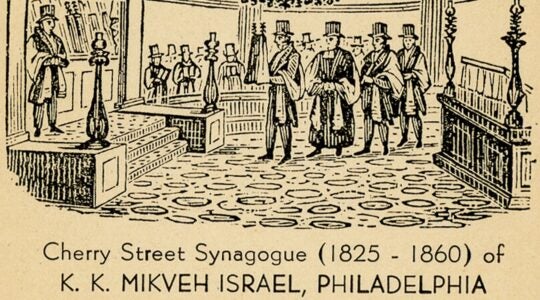Editor’s Note: This d’var torah was delivered at Darkhei Noam, a Manhattan congregation, on Saturday, April 20.
Today is the 25th day of the Omer [the 49 days between Passover and Shavuot]. One week from tomorrow, we will celebrate the 33rd day, Lag B’omer. Since Pesach, we’ve been in a period where we observe a set of customs related to mourning. Customs vary across communities, but usually rule out weddings, haircuts, live music, and sometimes new clothes. What exactly are we mourning? The Gemara in Yevamot 62b teaches:
“It was said that Rabbi Akiva had 12,000 chevrutot (24,000 students)… All of them died in a single spell.”
A discussion ensues. Rabbi Chama bar Aba says the students died a cruel death. Rabbi Nahman says it was a plague. This Gemara offers an explanation for the Omer: we are in mourning for Rabbi Akiva’s students, and it is traditionally cited as the source for Lag B’omer. On the 33rd day, the plague came to an end. This view gets codified in halacha by establishing 33 days of mourning, and then, once the plague is finished, we end the mourning customs.
However, there are other halachic traditions about which days we observe the Omer. Some people keep the last 33 days, some people say you can keep any 33 days, and some people keep all the days except Lag B’omer. In tandem, there are different stories about where the customs come from. One particular source, comes from the Maharil, who lived in the 14th century in Germany. He compiled a well-known book of customs. About Lag B’omer, he wrote (Laws Between Pesach and Shavuot, Halacha 7):
“Rabbi Akiva’s students… died only on those days on which we say Tachanun [a prayer said on weekdays but not holidays] during the seven weeks of the omer. On those days where we don’t say Tachanun, they neved died… 7 days of chag, 3 days of Rosh Chodesh, and 7 shabbatot. This [49-17] leaves 32 days [spread throughout the omer] on which there was a plague. On day 33, we have a simcha l’zecher, a celebration in their memory.”
For the Maharil, the ongoing plague is a part of reality. While holidays offer a respite, the threat of deaths from this plague constantly hangs over us from Pesach until Shavuot. What’s the appropriate way to acknowledge this plague hanging over our head? He says that on the 33rd day, effectively in the middle of the plague, that we should have a festival to remember the students who died.
We’ve been building up together, as a collective, from Pesach and slavery to Shavuot and the glory of receiving the Torah. Tonight, we will count 26 days on this collective path.
My father-in-law says that when he is running a marathon, he feels interconnected with all the other runners, a wave of human emotion, moving inexorably towards freedom. On Monday, the runners in Boston were counting up to 26 miles. Monday’s attack hit particularly close to home for my family and me. My sister Anna and I grew up watching the Boston Marathon, passing water out to runners. My wife and father-in-law ran it when I was in college. On Erev Pesach two years ago, my wife and I got engaged at the finish line. This year, my Boston roommate finished in under 3 hours. We celebrated downtown and then hopped on the subway a few minutes before the bombs went off.
That night I went home, concerned for the many victims and thankful to feel safe and sleep in my own bed. On Friday the plague came back to Boston. We began to learn more details about the bombers. Their home on Norfolk St. in Cambridge was two blocks from my apartment, and also two blocks from Minyan Tehillah, Cambridge’s partnership minyan. The younger one was a lifeguard at the pool where I swim.
Boston invites students from around the world to its universities, my graduate program is about half foreign students. Boston invites runners from 90 countries to its marathon. This year, we find ourselves observing customs of mourning alongside the rest of America. This year, the students we are mourning were not from Gabbata and Antipatris, like the students of Rabbi Akiva, but they came from as close as Dorchester and as far away as China.
What should we make of Lag B’omer? The tradition attributed to the Gemara seems the most natural, with a clear sequence of historical tragedy followed by, at the end of the plague, a breath of relief.
We might wish we lived in a world like the gemara’s version of mourning–strict boundaries of loss. When someone dies, we tear our clothes, we sit shiva, we get up, shloshim ends, and we move on with our lives. In the decade of domestic security that followed 9/11, it felt as if terrorism was a historical event. Boston — and frequent terrorist attacks in Israel — rejects this notion. We live in a deeply uncertain world, where our most closely held traditions and values, like the marathon, might be attacked at any moment. And so, the Maharil’s position makes sense. We live in an uncertain world, and we cannot control when a plague will strike again. But, today, and in one week on Lag B’omer, we can still celebrate the memories of Krystle Campbell, Martin Richard, Lu Lingzi, and Sean Collier.
Peter Ganong is a Darkhei Noam member and a PhD candidate in Economics at Harvard University.
The New York Jewish Week brings you the stories behind the headlines, keeping you connected to Jewish life in New York. Help sustain the reporting you trust by donating today.




